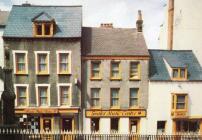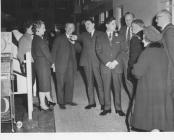Content can be downloaded for non-commercial purposes, such as for personal use or in educational resources.
For commercial purposes please contact the copyright holder directly.
Read more about the The Creative Archive Licence.
Description
Denomination: Roman Catholic
Built: 12th century
Photography: John Ball and Jennifer Benavidez
Date: 15 July 2000
Camera: Sony Mavica MVC-FD91 digital
History:
Abbeycwmhir is the site of an old abbey, reputed to have been the second largest religious house of the Cistercian order. Abbey-cwm-hir (abbey of the long valley) is claimed to have been founded in 1143 by Cadwallon ap Madoc, Lord of Moelynaidd, but this view is frequently challenged. In 1213, King Henry III, enraged by alleged treachery on the part of the monks, caused considerable damage to the abbey. In 1401 it was practically destroyed by Owain Glyndwr during his conflict with the English king. On the dissolution of the monasteries by King Henry VIII in 1542, the manors and lands belonging to the abbey, valued at under £30, were granted to Sir Thomas Williams, one of the Lords Marchers. The results of a detailed survey by the Clwyd-Powys Archaeological Trust are presented on the CPAT website
Image 1:
Photography by John Ball
The Abbey ruins are sited on lush meadowland on the floor of the valley of the Clywedog Brook. The area of the ruins is very extensive, about 255ft by 73ft, but the nature of the superstructure can now only be imagined, for only the foundations and the remains of the walls are left. The Abbey stood in a ten-acre enclosure and was strongly entrenched by earthworks thrown across the valley to the east (the left of the photograph) and west.
Image 2, 3:
Photography by John Ball
All that remains of the once celebrated abbey. The hill, prominent in the background, is known as Sugar Loaf.
Image 4:
Photography by Jennifer Benavidez
The eight-foot high walls in this corner of the abbey provide welcome shade from the afternoon sun.
Artefacts from the Abbey have been dispersed to various parts of Wales. Six pointed arches have been taken to Llanidloes, where they form part of the parish church. The ornate wooden choir screen is thought to have been taken to Newtown, Montgomeryshire. Much of the carved stonework was used in the construction of a nearby Elizabethan house. Stones from the walls were carried to Llanbister and used for the construction of its parish church.
It is claimed by some authorities that the remains of Llywelyn, the last native Prince of Wales, were interred in the Abbey. The story goes that in December 1282, while Llywelyn's forces were laying seige to Builth Wells on the Breconshire-Radnorshire border, he slipped away to his stronghold a few miles south of Builth. Early one morning, Llywelyn broke cover and attended mass in the village church. He was set upon and killed in a field at Cefn-y-bedd, a few miles west of Builth. His severed head was sent to the King, while his body found decent burial near the high altar at Abbeycwmhir, where a memorial slab (right) now marks the spot. In 1982, on the 700th anniversary of Llywelyn's death, a wreath of remembrance was laid here.
Image 5:
Photography by Jennifer Benavidez
References:
HAMMON, Reginald J. W. (ed), 1966. Red Guide - The Complete Wales. Ward Lock. London & Melbourne. GREGORY, Donald, 1993. Wales Before 1536 - A Guide. Gwasg Carreg Gwalch. Llanrwst, Denbighshire. ISBN 0-86381-250-3.














Do you have information to add to this item? Please leave a comment
Comments (0)
You must be logged in to leave a comment